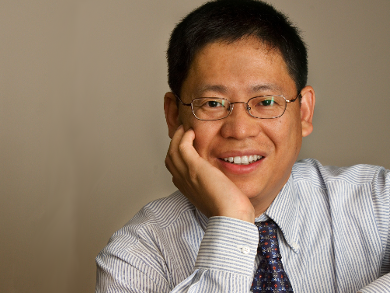Dr. Claire M. Cobley, Managing Editor of ChemNanoMat, talks to Professor Younan Xia from Georgia Tech, Atlanta, USA, about his recent article on radiolabeled gold nanocages published in ChemNanoMat. In this work, radioactive copper was incorporated into noble-metal nanostructures to enhance the contrast of positron emission tomography (PET) imaging of tumors in vivo.
Could you briefly explain the focus and findings of your article?
We have developed a facile and reliable method for labeling gold nanocages with radioactive 64Cu atoms. The labeling process only caused minor changes to the optical properties of the pristine nanocages. The resulting 64Cu-doped nanocages could be easily tracked in vivo by means of positron emission tomography. This makes it possible to quantitatively analyze the whole-body distribution of these materials. With such quantitative information, we can start to manage the therapy for a better treatment efficacy.
What was the inspiration behind this study?
Gold nanocages are promising for cancer therapy due to their remarkable photothermal properties. In reality, we have to know how to track them and quantify them after administration in vivo. For this purpose, various optical methods have been developed, but the shallow penetration depth of light greatly hampers their use in humans. Radiolabeling with 64Cu provides a better solution, as PET has already been used in the clinic.
Why was your attention focused on gold nanomaterials?
We choose to work with gold nanomaterials mainly because of i) the well-known bioinertness and thus good biocompatibility of gold, ii) the versatile thiolate-based chemistry for reliable surface modification, iii) the available well-established methods for synthesizing gold nanostructures with controllable sizes, shapes, and structures, and iv) the unique optical properties, broadly known as localized surface plasmon resonance, associated with gold nanostructures. This includes the extremely large scattering and absorption cross-sections tunable to the near infrared for both optical imaging and photothermal therapy.
How did you become interested in metal nanostructures?
Metal nanostructures have a long history of interesting applications. I became interested first because of their shape-dependent physicochemical properties, and later their unique applications in cancer theranostics, catalysis, and fuel cell technology.
Which part of the work proved the most challenging?
The most challenging part of our study is the deposition of copper on gold. First of all, we need to avoid self-nucleation when a copper salt precursor is reduced into elemental copper and ascorbic acid was identified as a proper reducing agent to realize this goal. In addition, it was initially discovered that the deposited copper layer was not stable, and we addressed this issue by co-depositing copper with gold as an alloy. Finally, one has to properly control the reduction kinetics relative to surface diffusion of adatoms in an attempt to generate smooth coating.
Why did you choose patient-derived xenograft tumor models?
For most studies in cancer nanomedicine, researchers tend to choose subcutaneous tumor models developed via local injection of cancerous cells. Such models tend to suffer from reproducibility and show poor correlation with human cancer in terms of pathology.
In this study, we used the patient-derived xenograft tumor model (PDX model; cancerous tissue from a tumor is implanted into an immunodeficient mouse), which is grown from tumor tissues freshly harvested from cancer patients. This model, with well-established tumor microenvironment and stroma components, could better mimic the pathological features of human cancer.
What distinguishes your work from other systems that have been reported in recent years?
Most studies and clinical trials of PET imaging take advantage of chelated copper isotopes like DOTA-64Cu which suffer from limited blood availability, high off-target cytotoxicity, and non-controllable leaching of isotopes.
In our study, we created a chelator-free platform with high stability and biocompatibility. Although the concept of depositing radioactive copper on nanostructures is not new, our study is the first demonstration of successful deposition of radioactive copper on gold nanocages to create a PET-guided theranostic platform. This method can also provide inspiration for the future development of other kinds of theranostics.
Do you have any plans for future work extending from this study?
The current research offers a general and robust method to label gold nanomaterials with radioactive 64Cu for PET. We will apply this method to investigate the biodistribution of gold nanomaterials with various sizes, shapes, and morphologies, as well as different surface modifications, after their systemic administration, in an attempt to identify the optimal materials for cancer therapy. In the long term, we aim to design and fabricate a nanoscale “magic bullet” based on gold nanocages that will integrate a broad range of functionalities and capabilities to conquer cancer.
What advice or words of wisdom would you give to young scientists who are starting their own independent research careers?
The best strategy for initiating a research project is to start with a problem, a kind of big problem, that you would intend to address or solve. For me, I got involved in the research on noble-metal nanostructures because I saw a real problem in the field, that is, the poor control in terms of size, shape, composition, and structure. At the very beginning, I was not sure if we were able to succeed because of the long history of this field and the lack of tools for understanding the atomic details. In retrospect, I think my decision was rewarded with lots of unexpected discoveries and excitement and this field has advanced significantly because of the contributions from my group.
- Facile Synthesis of 64Cu-Doped Au Nanocages for Positron Emission Tomography Imaging,
Miaoxin Yang, Da Huo, Kyle D. Gilroy, Xiaojun Sun, Deborah Sultan, Hannah Luehmann, Lisa Detering, Shunqiang Li, Dong Qin, Yongjian Liu, Younan Xia,
ChemNanoMat 2016.
DOI: 10.1002/cnma.201600281



